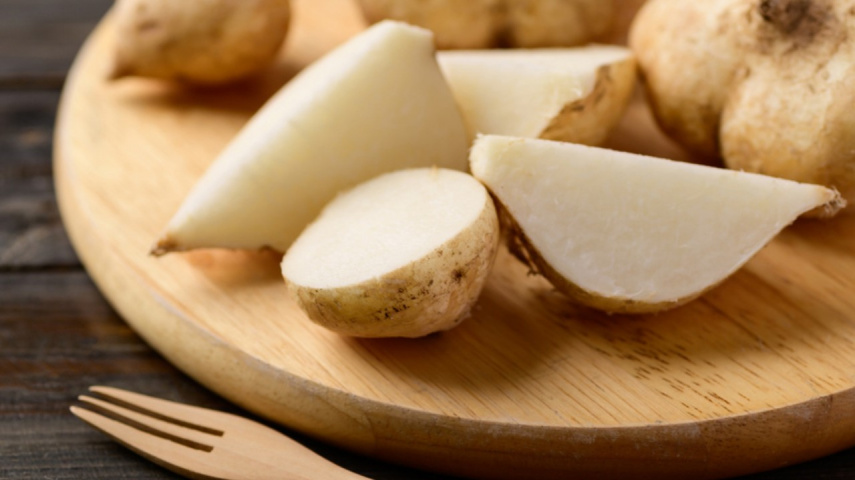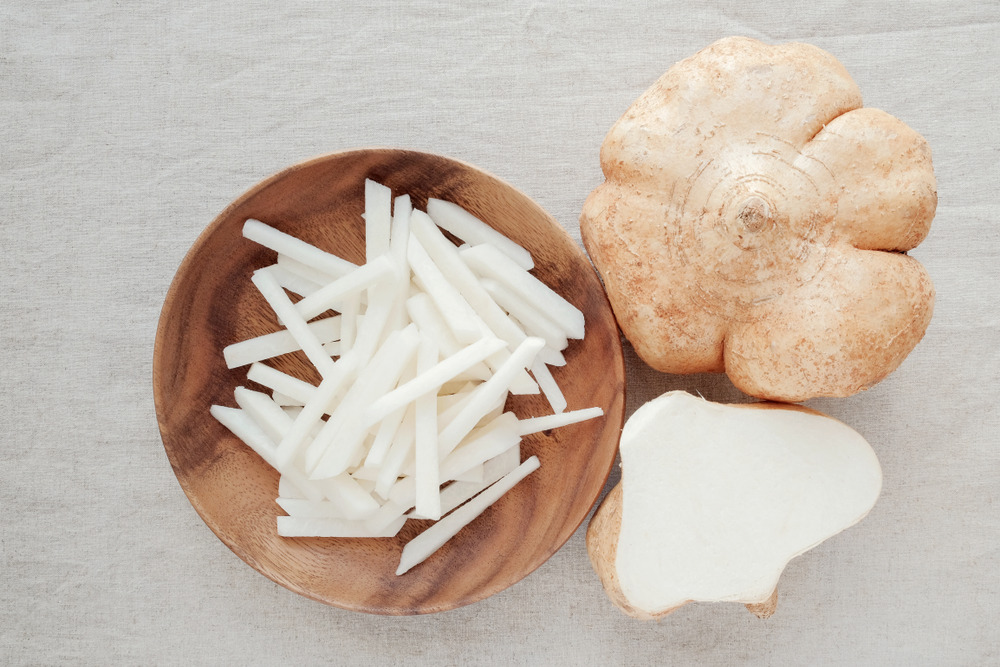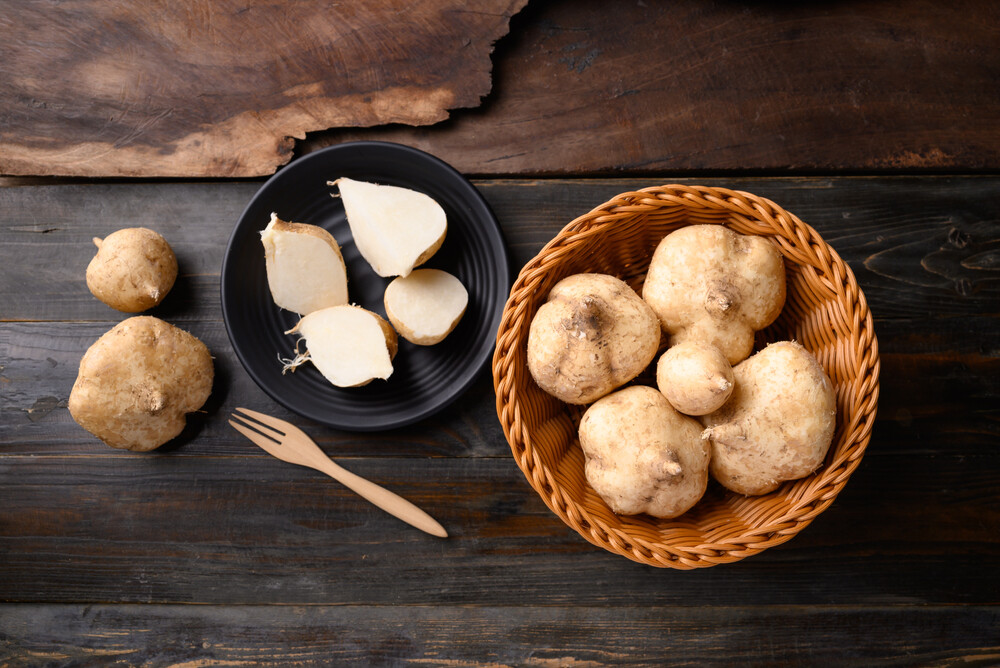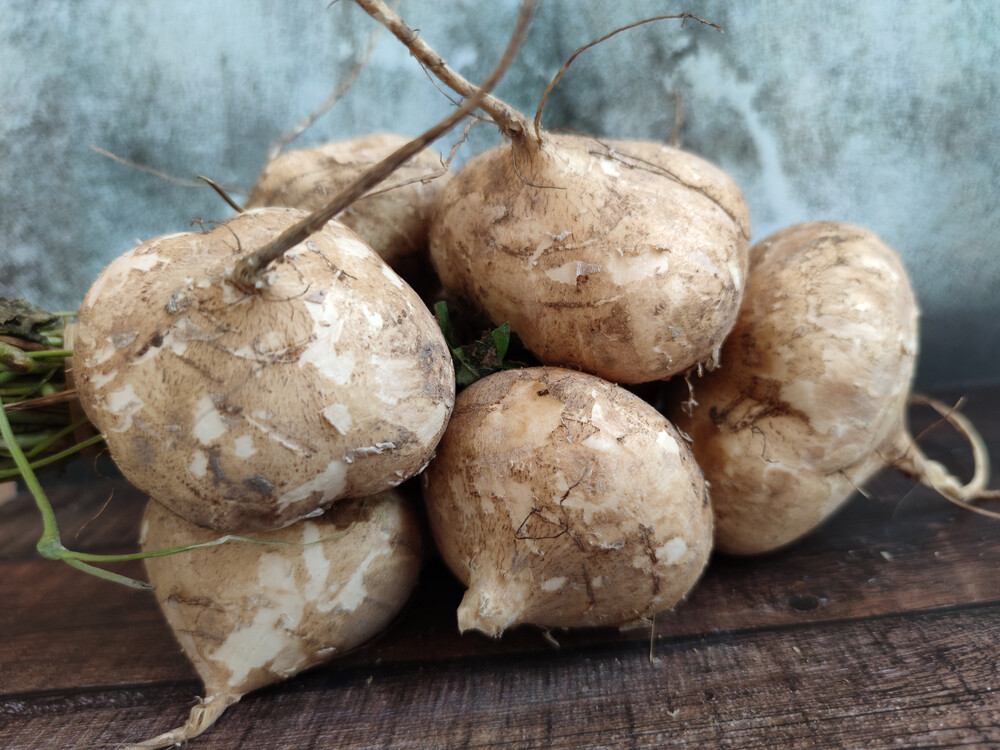Unique Benefits of Jicama: A Diabetes Friendly Vegetable
Explore the benefits of Jicama with some fresh salads and stir-fries. This age-old vegetable will make you swoon with its flavors and nutritious benefits.

There are many unearthed fruits and vegetables in the world that can make you healthier. The Jicama plant which bears what is known as the Mexican potato, is one of these hidden vegetables that is widely used in Central America. It is a tuberous plant with brown skin replete with many benefits for humans. The edible part of the plant is under the ground and is the tuber. It is alternatively termed as Mexican water chestnut as well. The Jicama root is rich in fiber and helps you manage blood cells, blood sugar, and blood pressure, and is thus a great food for those suffering from cardiovascular diseases. The benefits of Jicama are many, but you must also watch out for its side effects. Read this blog to learn more about this vegetable's benefits and its overall effect on your body and mind.
Jicama Nutrition Value

Jicama is a crunchy, juicy root vegetable native to Mexico and Central America. It is a member of the legume family, and its scientific name is Pachyrhizus erosus. The name "jicama" comes from the Nahuatl word "x?camatl," which means "tuberous root."
Jicama is a large, brown-skinned vegetable growing up to 20 inches long. The flesh of the Jicama is white and crisp. It has a slightly sweet, at times summit, and nutty flavor. It has a texture similar to a water chestnut but is less watery (1). Dr. Ben Carvosso, a renowned chiropractor and the owner of MP Nutrition, says, “Jicama differs in taste, boasting a mild sweetness and crisp texture, unlike yams, cassava, and sweet potatoes. Nutritionally, jicama is lower in calories and starch, and rich in fiber and vitamin C.” It is also a low-calorie food. Its calorie count makes it a healthy choice if you're trying to stay healthy. Jicama can be eaten raw, cooked, or pickled. It is often used as an add-on in salads, stir-fries, and even soups (1).
Our contributor Mary Sabat, RDN, LD, and Ace Certified Trainer, shares, “Jicama is a versatile vegetable used in various culinary preparations. It's commonly used in salads, providing a crunchy texture and a slightly sweet, refreshing flavor. Jicama sticks or slices are popular as a raw snack, often served with dips like guacamole or hummus. Additionally, jicama can be added to stir-fries, slaws, and Mexican dishes like ceviche for its unique texture and ability to absorb flavors from other ingredients.”
The nutritious benefits of Jicama can help the body in various ways. Here is the nutrition value of Jicama per 1 cup (130g) in sentences (2):
- Jicama has 49 calories per cup.
- 1 Cup of Jicama has 0.1 grams of fat. This quantity has 0 grams of saturated fat and 0 milligrams of cholesterol.
- There are 5.2 milligrams of sodium, 195 milligrams of potassium, and 11 grams of total carbohydrates in 130g of Jicama. It has 6 grams of dietary fiber, 2.3 grams of natural sugar, and 0.9 grams of protein.
- One hundred thirty grams of Jicama also contributes to 43% of the daily value of vitamin C, 1% of the daily value of calcium, 2% of pantothenic acid, and 4% of the daily value of iron.
- It is also a healthy source of Vitamin B6.
10 Health Benefits of Jicama

Eating healthy is the key to having a healthy body. While exercising regularly maintains the fitness of your physique, the food that goes into your system is critical in determining your well-being. Any food that you consume must have the following features to make it healthy for the body.
- Fiber: Fiber is essential for gut health. It keeps the large intestines clean and healthy. Fibre also aids in water absorption and keeps the body light (3).
- Prebiotics: Prebiotics are food for good bacteria in your stomach. They are instead fermented by the good bacteria in the gut. They help to improve gut health (3).
- Probiotics: Probiotics are live bacteria, similar to the good bacteria that naturally live in the gut. These bacteria help in breaking down complex food and absorbing nutrients (3).
- Antioxidants: Antioxidants can help to protect the gut from damage. These compounds also keep the connective tissue young (3).
- Water: Water is essential for gut health. It helps with smooth muscle function and helps to flush out toxins. And, a high water content is one of the most prominent benefits of Jicama (3). “Jicama is notably water-rich, containing around 90% water content, similar to cucumbers and slightly more than kale. However, compared to exceptionally hydrating fruits like cantaloupes, peaches, and oranges, which also contain around 85-90% water, jicama's water content stands relatively equivalent,” continues Dr. Ben.
Jicama has a few of the above-mentioned properties, making it good for the body. It also has many additional properties that make it better for diabetic people. This vegetable has the following benefits for the body.
- High in Fiber: Jicama's fiber helps with digestion, weight loss, and blood sugar control. Hence it helps with the timely movement of roughage and helps with adequate water absorption (4).
- Prebiotic: Jicama contains inulin, a type of prebiotic that feeds the good bacteria in your gut. This can help improve gut health and immunity. The long-term effect of this vegetable also helps to fight against infection (4).
- Low Glycemic Index: There are many benefits of Jicama for diabetics. Jicama has a low glycemic index or low glycemic load. It does not make your blood sugar levels rise. You can have it as a stir-fried snack as well, and it does not spike your sugar levels (4).
- Good Source of Antioxidants: Jicama protects cells from damage. Both these compounds help in protecting the inner lining of the gut and keep you healthy. This is one of the benefits of Jicama for skin (4).
- Fights Cancer: The antioxidants in Jicama may help protect against cancer. In particular, Jicama has been shown to inhibit the growth of colon cancer cells (4).
- Enhances Heart Health: Jicama contains soluble fiber, which can help lower cholesterol levels and help fight heart diseases. A higher heart rate ensures your body burns more fat, and it secures your liver from developing fatty liver syndrome (4).
- Promotes Digestion: The fiber in Jicama can help keep your digestive system running smoothly. All this is due to the fiber content of Jicama (4).
- Good for Your Gut Bacteria: The prebiotic fiber in Jicama can help improve the balance of bacteria in your gut. This can have a number of benefits for your overall health, including improved digestion, immunity, and mood. It is one of the most crucial benefits of Jicama (4).
- It May Aid in Weight Loss: Benefits of jicama juice include it being low in calories. This high-fiber food can help you feel full (4).
- Extremely Versatile: Jicama can be eaten raw, cooked, or pickled. As this vegetable has an umami taste, you can make multiple things out of it. People on a diet can easily consume this without any worries (4).
Side Effects of Jicama

Jicama is tasty and has many benefits for the body. But you must remember that everything is healthy only in a limited quantity. It also depends on the kind of disease you already have. Jicama is a healthy vegetable that is generally safe to eat. Jicama side effects are to watch out for, especially for people who have stomach issues. should be aware of.
- Gas: Jicama is a high-fiber food that can cause gas in some people. If you are sensitive to fiber, you may want to start by eating small amounts of Jicama and gradually increase your intake (5). Even though there are many benefits of Jicama, you must watch out for this side effect.
- Bloating: Jicama can also cause bloating in some people. This is also due to its high fiber content (5). If you are prone to bloating, you may want to avoid Jicama or eat it in moderation.
- Indigestion: Jicama can also cause indigestion in some people. It is because it is a high-fiber food that can be difficult to digest (5). If you have a sensitive stomach, you may want to avoid Jicama or eat it in moderation.
- Allergic Reaction: Sometimes, people may experience an allergic reaction to Jicama. Some people have allergic reactions due to compounds in tuberous vegetables that cause itching. You could also get itching and redness in the throat. If an elder in the family has this issue, you must be cautious when eating Jicama. Start with small portions and only then go for a bigger piece (6).
If you or people in your family are allergic to tuberous vegetables, it is better to consult your family doctor before consuming them. If you love the taste of this vegetable, you can always find ways to eat it the right way.
- Cook Jicama: Cooking Jicama can help to break down the fiber. This process makes it easier to digest and enhances the benefits of Jicama. Cooking also reduces the harmful compounds that irritate the throat less (7).
- Soak Jicama: Soaking Jicama in water for an hour before eating can also help to reduce the fiber content. Most vegetables lose any water-soluble harmful compounds by soaking them in water (7).
- Avoid It: Avoid eating Jicama if you have a sensitive stomach. If you have a sensitive stomach, you may want to avoid Jicama or eat it in moderation.
Conclusion
There is no doubt that the benefits of Jicama are wonderful for your well-being. Its antioxidative properties and fiber content are all healthy. It helps you stay in shape while ensuring you get delicious nutrition. But this vegetable has some side effects as well. People who have a tendency for low blood sugar should avoid it as it can further reduce blood sugar to dangerous levels. Moreover, people who have issues like bloating and gas should also try to avoid Jicama. This vegetable often causes gas for those who are not used to eating much fiber. When you begin eating it, you should start small and gradually increase your portion size.
Contributor: Mary Sabat, RDN, LD, Ace Certified Trainer - Body Designs Ltd.
ALSO READ: Yoga for Muscle Building to Make Your Body Flexible And Strong





 JOIN OUR WHATSAPP CHANNEL
JOIN OUR WHATSAPP CHANNEL
































































































